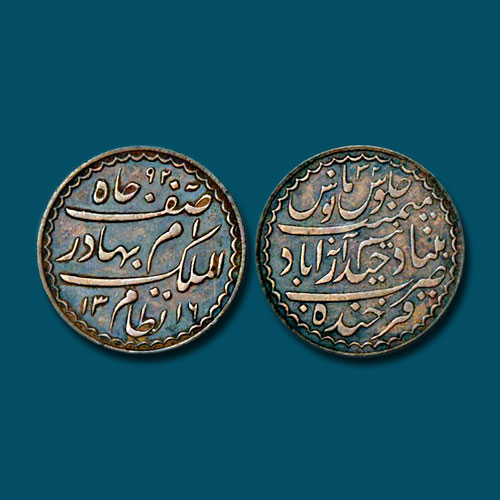Mir Mahboob Ali Khan was born today
2019-08-17 Sat
The sixth Nizam of Hyderabad, Mir Mahboob Ali Khan was born on 17th August 1866. He came to the throne at the age of three in 1869 and ruled till 1911.Mahboob Ali was the youngest son of Nizam Afzal-ud-Daulah. He ascended the throne under the regency of Dewan Salar Jang I and Shams-ul-Umra III. He was the first Nizam to be exposed to western education.
Mahboob Ali was a perfect example of a Victorian Prince. He had a great taste for western culture and modern ways of life. Hyderabad continued to grow and it enjoyed peace and stability under his reign.
He issued various coins in gold, silver, copper, bronze, and tin in rectangular and round space. These coins were issued in the denomination of Ashrafi, Rupee, Anna, Pai, and Paisa.
The above-shown copper pattern half Anna was issued in his reign. The obverse of the coin is inscribed with the Persian legend ‘Nizam-ul-Mulk Bahadur Asaf Jah’ with Persian letter (Meem) for Mahboob, Sanah 1316 and Numeral 92 which is Numerical value of the name “Muhammad”. The reverse of the coin is read as ‘Zarb Farkhanda Bunyad Hyderabad Julus Mainamat Manus’, RY 32, and denomination Neem Anna added in the second line. Image Source: Classical Numismatic gallery
Latest News
-
Malwa Sultan Mahmud Shah Silver Coins
2025-09-11 ThuMalwa Sultan Mahmud Shah minted silver coins in round and square flans. <br><br> For round coins,...
-
Malwa Sultan Mahmud Shah Billon coin
2025-08-26 TueMalwa Sultan Mahmud Shah's billon coins followed three weight standards: 100 rati, 96 rati, and 80 r...
-
Fascinating Archaeological Facts on Postage Stamps - 91
2025-08-23 SatRhinoceros is one of the oldest land mammal species existing in India. There are five species of rhi...
-
Fascinating Archaeological Facts on Postage Stamps - 90
2025-08-23 SatUthiramerur, a Village in Kanchipuram, Tamil Nadu, is notable for its Temple inscriptions that descr...
-
Fascinating Archaeological Facts on Postage Stamps - 89
2025-08-21 ThuThe term “millet” is derived from the Latin word “milum,” which translates to grain. millets...

